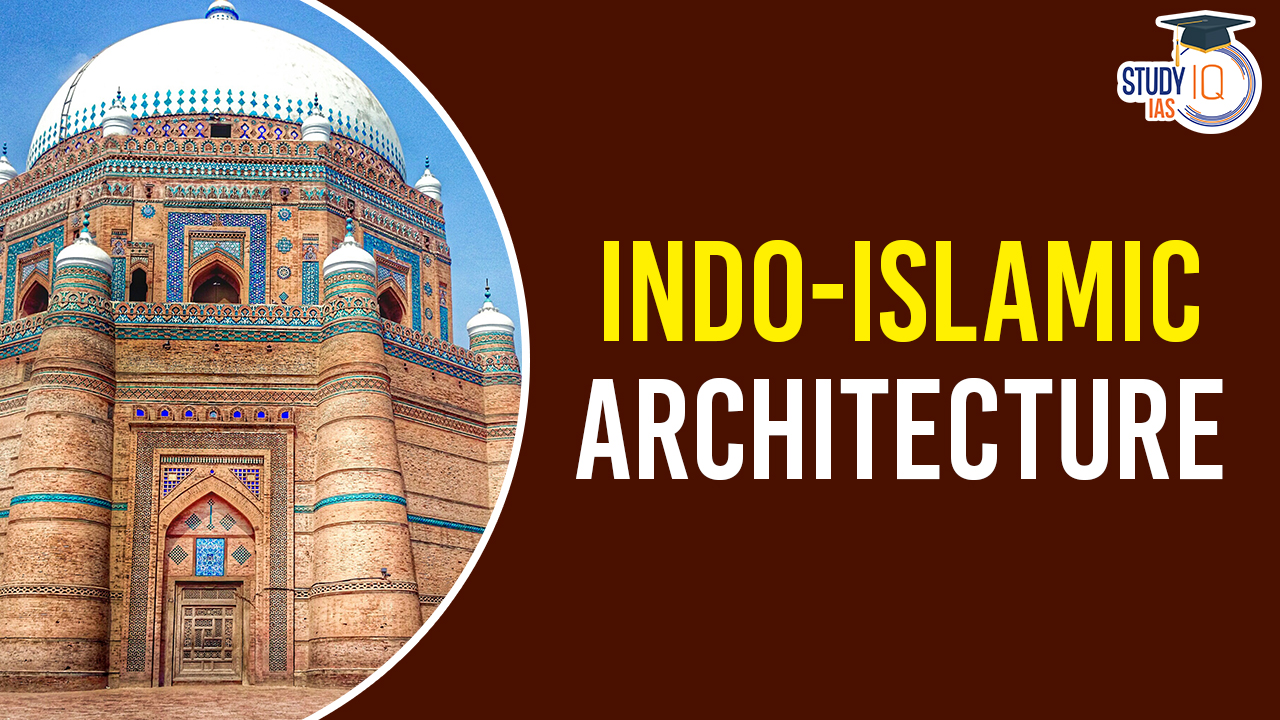Table of Contents
Indo-Islamic architecture refers to the architectural styles that emerged in the Indian subcontinent as a result of the fusion of Indian and Islamic influences. This style developed over several centuries, starting with the arrival of Islam in the Indian subcontinent in the 7th century and continuing through the Mughal Empire and subsequent periods.
Indo-Islamic Architecture
Indo-Islamic architecture, a fusion of Indian and Islamic influences, emerged from the 7th century onwards, evolving through distinct periods. Characterized by ornate domes, slender minarets, and intricate arches, it showcases a harmonious blend of Arabic calligraphy, geometric patterns, and lush courtyards. The Ghaznavid and Ghurid periods saw the initial synthesis, while the Delhi Sultanate and Mughal era produced iconic structures like the Qutub Minar and Taj Mahal. This architectural style extends beyond the Mughals, with diverse influences visible in structures across the Indian subcontinent, exemplifying a captivating journey of cultural integration and artistic expression.
We’re now on WhatsApp. Click to Join
Indo-Islamic Architecture: Background
Islam spread to Spain and India during the seventh and eighth centuries Common Era (CE), facilitated by Muslim merchants, traders, holy figures, and conquerors over six centuries. The Delhi Sultanate, established after the Turkish conquest of northern India in the early thirteenth century, marked the onset of extensive building activity. Notably, Muslims assimilated local cultural features during migrations and conquests, incorporating them into their architectural practices.
These hybrid styles are recognized as Indo-Saracenic or Indo-Islamic architecture. Unlike Hindus, who revered god in various forms, Muslims focused on a singular manifestation with Muhammad as their Prophet. Consequently, Hindus adorned surfaces with sculptures, while Muslims, restricted from replicating living forms, expressed their religious art through arabesque, geometrical patterns, and calligraphy on plaster and stone.
Characteristics of Indo-Islamic Architecture
Here you can check the Characteristics of Indo-Islamic Architecture:
Typologies of Structures
Addressing both religious and secular needs, various architectural structures were erected, such as mosques for daily prayers, Jama Masjids, tombs, dargahs, minars, hammams, formally planned gardens, madrasas, sarais or caravansarais, Kos minars, etc.
Influences
Despite Saracenic, Persian, and Turkish influences, Indo-Islamic structures incorporated prevalent sensibilities of Indian architectural and decorative forms.
Categories of Styles
Indo-Islamic architecture is traditionally classified into:
- The Imperial Style (Delhi Sultanate)
- The Provincial Style (Mandu, Gujarat, Bengal, and Jaunpur)
- The Mughal Style (Delhi, Agra, and Lahore)
- The Deccani Style (Bijapur, Golconda)
Decorative Forms
- Designing on Plaster: Incision on plaster, either left plain or adorned with colours.
- Motifs: Painted or carved motifs, including various flowers from the subcontinent and beyond, notably Iran.
- Lotus Bud Fringe: Utilized in the inner curves of arches for aesthetic appeal.
- Arches: Varied in form, ranging from plain and squat to high and pointed.
- Wall Decorations: Featured cypress, chinar, and other trees, as well as flower vases.
- Tiles: In the 14th, 15th, and 16th centuries, tiles adorned walls and domes.
- Relief Carving: Both high and low relief carving, along with extensive use of jalis.
- Surface Decoration: Utilization of tessellation (mosaic designs) and pietra dura, especially in dado panels.
Roof Composition
The roof comprised a central dome, smaller domes, chatris, and miniature minarets. Indo-Islamic architecture thus reflects a harmonious blend of diverse influences, resulting in a rich and distinctive architectural heritage.
Components of Indo-Islamic Architecture
| Component | Description | Examples |
| Minars | Towers known as minars served various purposes, with the most notable being the call to prayer (azaan). The Qutub Minar in Delhi and the Chand Minar at Daulatabad Fort are exemplary medieval minars. Its towering height symbolized the ruler’s might and power. |
|
| Tombs | Monumental structures erected over the graves of rulers and royalty, were often adorned with Quranic verses. Examples include the tombs of Ghyasuddin Tughlaq, Humayun, Abdur Rahim Khan-i-Khanan, Akbar, and Itmaduddaula. Tombs were integrated into paradisiacal settings with gardens or water bodies, as seen in Humayun’s tomb and the Taj Mahal following the char bagh style. |
|
| Sarais | Square or rectangular structures were designed to provide temporary accommodation for diverse travellers such as Indian and foreign tourists, pilgrims, merchants, and traders. Sarais facilitated cross-cultural interactions, influencing local culture. |
|
| Structures for Common People | Public and private architectural features for non-royal segments of society, showcasing a convergence of styles and techniques. This category includes buildings for domestic use, temples, mosques, khanqahs, dargahs, commemorative gateways, pavilions in buildings and gardens, bazaars, etc. |
|
Provincial Influence on Indo-Islamic Architecture
Situated at an elevation of over 2000 feet in Madhya Pradesh, Mandu boasts a strategic location, overlooking the Malwa Plateau to the north and the Narmada Valley to the south. This terrain, coupled with Mandu’s rich history of habitation by Parmana Rajputs, Afghans, and Mughals, contributed to its significance.
As the capital of the Ghauri Dynasty (1401-1561), founded by Hoshang Shah, Mandu gained prominence. Beyond its political importance, the city became synonymous with the romantic tale of Sultan Baz Bahadur and Rani Rupamati. Even the Mughals sought refuge in Mandu for leisure during the monsoon season.
Mandu exemplifies the medieval provincial style influenced by Indo-Islamic architecture. Characterized by a blend of official and residential-pleasure palaces, pavilions, and buildings designed to dissipate heat, Mandu’s architectural ensemble is constructed using local stone and marble. The royal enclave, centred around two artificial lakes, showcases a cluster of palaces and structures.
| Structure | Description |
| Hindola Mahal | Resembling a railway viaduct bridge with substantial buttresses, the Hindola Mahal served as the Sultan’s audience hall. The innovative use of batter created a visually striking swinging effect on the walls. |
| Jahaaz Mahal | Sultan Ghiyasuddin Khilji’s creation, the Jahaaz Mahal, stands gracefully between two reservoirs. This ‘Ship Palace’ boasts overhanging balconies, an open pavilion, and a terrace. It functioned as a harem and a luxurious pleasure resort, featuring intricate watercourses and a terrace swimming pool. |
| Rani Rupamati’s Pavilion | Perched on the southern embattlements, Rani Rupamati’s double pavilion provided a breathtaking view of the Narmada valley. This pavilion contributed to the romantic ambience of Mandu. |
| Hoshang Shah’s Tomb | A testament to Afghan architectural strength, Hoshang Shah’s Tomb is majestic and robust. It showcases a beautiful dome, marble jaliwork, porticos, courts, and towers. |
| Jama Masjid | Constructed on a grand scale to accommodate Friday prayers, the Jama Masjid features red sandstone facing. Carved brackets support the Mimbar (platform for the Imam), and the Mihrab is adorned with a lotus bud fringe. |
Examples of Indo-Islamic Architecture
| Example | Location | Significance |
| Mandu | Madhya Pradesh | Representative of medieval provincial style, showcasing a mix of official and residential-cum-pleasure palaces, pavilions, mosques, artificial reservoirs, baolis, embattlements, etc. |
| Taj Mahal | Agra | The finest specimen of Mughal architecture, constructed in memory of Shah Jahan’s wife Mumtaz Mahal. Features include calligraphy, pietra-dura works, foreshortening technique, Charbagh style gardens, and the use of water for decoration. |
| Gol Gumbad | Bijapur, Karnataka | Mausoleum of Muhammad Adil Shah, notable for its monumental square building with a circular drum supporting a grand dome, making it the second-largest dome in the world. Features a whispering gallery along the drum. |
| Jama Masjid | Various locations | Large mosques for Friday prayers, serving as the focal point for both Muslim and non-Muslim communities. Characterized by open courtyards, cloisters, Qibla Liwan, mihrab, and mimbar. |
| Qutub Minar | Delhi | A 234-feet-high tapering tower built in the 13th century, featuring polygonal and circular shapes, decorated balconies, and bands of inscriptions. |
| Chand Minar | Daulatabad, Maharashtra | A 14th-century tower with four storeys, featuring Iranian and local architectural influences, including chevron-patterned encaustic tile work and Quranic verses. |
| Humayun’s Tomb | Delhi | First garden-tomb on the Indian subcontinent, built in 1570 under the patronage of Emperor Akbar. Designated as a World Heritage Site by UNESCO in 1993. Houses over 150 Mughal family members. |
| Red Fort | Delhi | Constructed by Shah Jahan as the residence of Mughal rulers, designated as a UNESCO World Heritage Site in 2007. |
| Badshahi Mosque | Lahore, Pakistan | Built during the reign of Aurangzeb, once the largest mosque in the world upon completion in 1673. Located in Lahore, capital of the Pakistani province of Punjab. |
| Agra Fort | Agra | One of the first constructions during Akbar’s reign, serving as the residence for Mughal rulers. Housed over 5000 women in Akbar’s harem. |
| Fatehpur Sikri | Fatehpur Sikri, Uttar Pradesh | Created by Akbar as a new capital city, featuring a unique blend of Hindu and Persian styles. Notable buildings include Buland Darwaza, Salim Chishti’s Tomb, Panch Mahal, and Jodha Bai’s Palace. Described as a frozen moment in history. |
Indo-Islamic Architecture UPSC
Indo-Islamic architecture, a fusion of Indian and Islamic styles evolving from the 7th century, showcases ornate domes, slender minarets, and intricate arches. Influenced by Arabic calligraphy, geometric patterns, and lush courtyards, it spans Ghaznavid, Ghurid, Delhi Sultanate, and Mughal periods. The style, evident beyond the Mughals, reveals diverse influences in structures across the subcontinent, representing a cultural integration journey. Notable features include typologies like mosques and tombs, diverse decorative forms, and distinctive styles across regions. Mandu, exemplifying provincial influence, boasts structures like Hindola Mahal and Jahaaz Mahal. Other iconic examples include Taj Mahal, Qutub Minar, and Jama Masjid.


 Bihu Festival and Dance of Assam, Histor...
Bihu Festival and Dance of Assam, Histor...
 Chittorgarh Fort: Mining Ban within 10 k...
Chittorgarh Fort: Mining Ban within 10 k...
 PM Modi visits Wat Pho Temple in Bangkok
PM Modi visits Wat Pho Temple in Bangkok





















